Long Island Peruvian restaurants to explore

Picchu Picada with choros a la chalaca (Peruvian mussels), papa a la huancaina (Peruvian potato), mini jalea (fried seafood), and leche de tigre (Peruvian ceviche) at Picchu in Selden. Credit: Yvonne Albinowski
Peru has long been a South American favorite when it comes to global cuisine. Four of the 50 restaurants on the recognized World’s 50 Best Restaurants list are in Lima, with chef Virgilio Martinez’s Central restaurant holding the No. 1 spot. Never known to buck a food trend, Long Island's Peruvian food scene has evolved just as robustly.
A burst of Peruvian restaurants opened throughout Nassau County in 2017-18: Jalea in Hicksville, Smoked Barn in Levittown, and La Vicharra Grill in Glen Cove. By 2021, the original La Candela expanded from Hicksville into Huntington, solidifying Peruvian’s hold on diners. In the past year, a new collection of restaurants elevated the options, some with flashy new dining rooms, others with robust entertainment, but always a menu of familiar ceviches, Pisco cocktails and lesser-known classics begging to be explored.
Centereach couple Christina and Harry Caldera, owners of Picchu in Selden, fell in love with Peruvian cuisine during their food travels and grew frustrated with the lack of it in their area during the pandemic. Supplementing their respective day jobs as a teacher and lighting designer, the duo opened a Peruvian restaurant in central Suffolk. “The more time we spent in Queens, in Miami, we realized we wanted to find a way to share this colorful cuisine with our community, closer to home. When the opportunity presented itself, we grabbed it,” explained Harry.
Their chef hails from the northern port city of Chimbote, and everything about her “leche de tígre,” the milky juice that collects at the bottom of ceviche — the aroma, the tang on the tongue, the bite of the lime, the brine of the fish — evokes sitting in one of Lima’s ubiquitous cevicherias, slurping. The 20-seat spot also highlights traditional recipes like arroz con mariscos, a seafood dish akin to paella; jalea, fried, mixed seafood topped with chopped onion, tomato, and cilantro; salchipapas, or French fries mixed with hot dogs, and tallerines verdes, or spaghetti in a pesto-like sauce without nuts or basil.
FOOD OF PERU
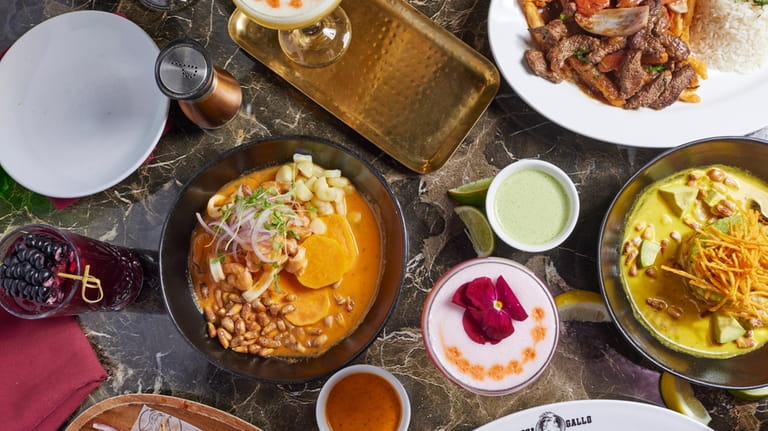
Ceviche mixto with white fish cubes, shrimp, calamari, cubed scallops and octopus in a spicy lime "leche de tigre," topped with red onion and served with sweet potatoes and Peruvian corn at Pappagallo in Rockville Centre. Credit: Yvonne Albinowski
Peru — with the Andes Mountains in the center, the Pacific Ocean to the west, a long, jungle border with Brazil to the east — is a harbor for lush ingredients. The country has given the world more than 4,000 varieties of potatoes (many of which have disappeared), quinoa, countless types of peppers (or ajiís) and heirloom corn. The coast brings a variety of seafood, while the jungle offers an abundance of yuca, another dietary staple. Immigrants rounded out the cuisine. The Spanish introduced olives, grapes, dairy, chicken and beef; the Chinese and Japanese contributed techniques like stir-fry and sushi. Italian-inspired tallerines, or noodles, make Peruvian food just as accessible to kids as to the adventurous who prefer carnivorous grilled delicacies like cuy (guinea pig) or anticuchos (skewered beef hearts).
The New York City-based Pio Pio, which opened in Glen Cove in 2023, is an upscale addition to Long Island with a more swank, rounded experience and a menu including mashed potato-based causas to a medium-rare lomo saltado, and that unforgettable pollo a la brasa, or rotisserie chicken.
“In the city spots, it’s a quicker take-away experience; everyone moves faster there,” said bartender Juan Carlos Chavero. “Out here, people are more curious. They have more time. They’re not in a rush. They try more things. It’s not just about the chicken.”
Marjry Moreno, 25, and her mother, Nelly Ponce, own the unassuming Inka Fe Café, which opened nine months ago in Great Neck. Born in Peru and living in Elmont since she was 2, Moreno has always had a penchant for baking. But when the pandemic rendered her psychology degree temporarily useless, she followed in her mom’s footsteps, selling alfajores, Latin America’s beloved dulce de leche cookies, to a local Peruvian restaurant.
From cookies to cupcakes, Instagram helped Moreno’s baking take off. “I didn’t know how to use a dishwasher before this,” Moreno laughed. “But after the pandemic, having a place for our community to learn about the foods of my country, with my mom, feels like the right thing.” Everything from the butter to the shortening to the flour to the soy sauce comes from Peru. Their entire staff is also Peruvian —“it’s a pride thing,” Moreno said.
With few cuisines as wide ranging as Peru’s, many Long Island diners are aware of the popularity of Peruvian food in general, but unfamiliar with more than ceviche and rotisserie chicken. Here is a lexicon of Peru’s most iconic foods, plus a listing of local restaurants where you can find them.
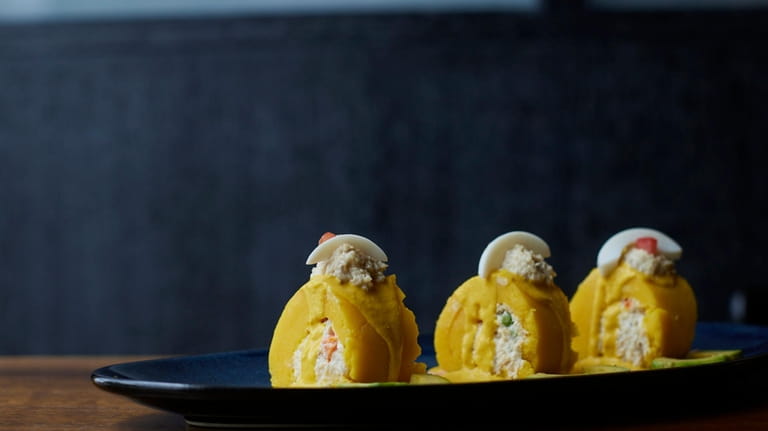
Causa de Pollo at Pio Pio in Glen Cove. Credit: Yvonne Albinowski
Anticuchos
Found predominantly as a street food along Lima’s roads, these skewered, grilled meats — traditionally beef or veal hearts — utilize ají panca, a pepper indigenous to Peru that can be found in dried or paste form in the United States, combined with garlic, onion, cumin, black pepper and vinegar. The meat is particularly fibrous, however, brushed with its signature marinade and grilled, they are the quintessential street snack.
Papa a la huancaína
With thousands of species of potatoes growing across Peru’s central highlands, it’s hard to escape “papas” in any Peruvian diet, but the most vibrant, recognizable and popular potato dish has to be the canary yellow-colored spuds in papa a la huancaína, from Huancayo. Boiled potatoes are smothered in a creamy, mild, queso fresco-based sauce enhanced with garlic, onion and ají Amarillo peppers, giving it a sunny color.
Ceviche
The most well-known export from Peru’s culinary shores has to be ceviche, a fish or shellfish appetizer bathed in citrus, onion and cilantro, creating “leche de tígre” or the tangy, spicy, sour brine that binds the dish. Usually served with sweet potatoes, choclo, or large-kernel Peruvian corn, and a plantain chip, or cancha — corn nuts — for crunch, it has been recognized by UNESCO as an expression of Peruvian cuisine and Intangible Cultural Heritage of Humanity. Pro-tip: Drinking leche de tígre is said to cure hangovers.
Chaufa
Peru’s Chinese history runs deep. After the abolition of slavery in the mid-1800s, a labor shortage allowed for the mass immigration of people from China, who infused Peruvian food with Asian flourishes. Most popular? Arroz chaufa, aka chifa, or fried rice, made with peppers, scallions and eggs, a universal comfort food found on most Peruvian menus. Customize with a protein of choice — beef, chicken, shrimp or seafood.
Lomo saltado
Further encapsulating the country’s Latin-Asian fusion, this family-style entree features strips of steak — “lomo” means tenderloin in Spanish — stir-fried with red peppers, red onions and tomatoes over a bed of French fries, accompanied by a small mountain of white rice. The nicer the restaurant, the better quality and cut of the meat, which is marinated in an ají panca pepper and soy sauce that seeps into the starchy potatoes and rice.
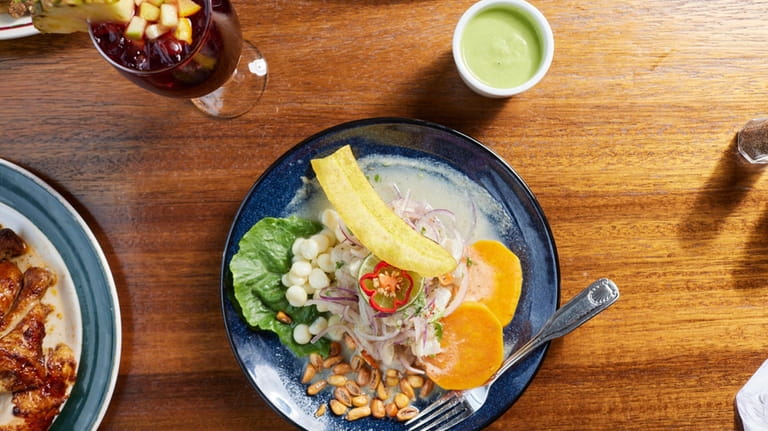
Ceviche Limeno with corvina, lime juice, red onions, cilantro and rocoto at Pio Pio in Glen Cove. Credit: Yvonne Albinowski
Pollo a la brasa (Peruvian chicken)
One of the most recognizable exports from Peru is rotisserie chicken, or pollo a la brasa, a long-brined, slow-cooked, spit chicken that delights even the most finicky eaters. The finger-lickin’ baste is made from a combination of ají Amarillo and ají panca, adding layers and heat to the dish. Dip into requisite salsa verde, or creamy, cilantro sauce, served alongside.
Chupe de camarones
From Arequipa, a southern city surrounded by volcanoes, this filling, fragrant shrimp chowder is a typical soup that picanterias, or casual lunch spots, would offer. Made with rice and corn, native ají Amarillo pepper, and thickened with potatoes and cream, it is often topped with a poached egg.
Picarones
Traced back to the Spanish, like a buñuelo but formed into mini doughnuts, picarones are Peru’s contribution to the fried, sweet dough category of dessert. Crisp on the outside, airy on the inside, they are normally found on the street, bubbling inside vast drums of hot oil, or skewered atop in a neat row of orange-hued halos. Made from squash and sweet potatoes, they are traditionally served with sugar cane syrup called chancaca. Hard to find in U.S. restaurants, if they’re on offer, order them.
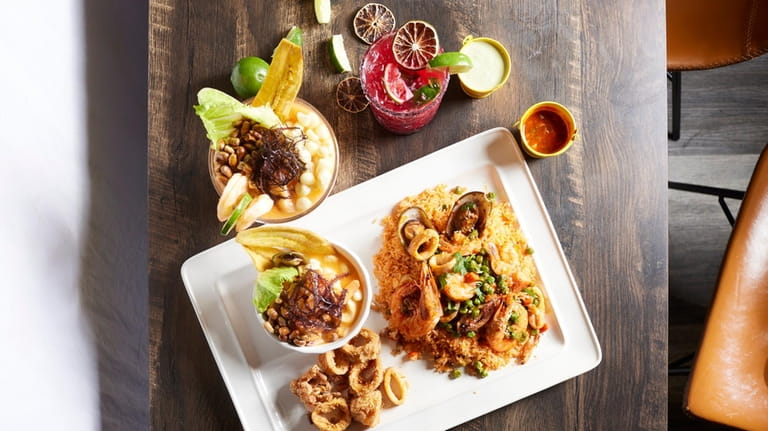
Picchu special with rice and shrimp, ceviche mixto and fried calamari at Picchu in Selden. Credit: Yvonne Albinowski
Alfajores
Originally hailing from Spain, alfajores are a traditional dulce de leche sandwich cookie found in most countries across South America. Made with flour, honey and nuts, the cookies have an earthy sweetness and a texture similar to shortbread. Tucked between is creamy, caramel-like dulce de leche, a Latin American delicacy made from milk, sugar and sea salt, sprinkled with powdered sugar or coconut, sometimes chocolate.
Pisco and chicha
Pisco, a grape-based brandy that is considered Peru's national spirit, is mild, a subtly sweet liquor that anchors the frothy, emblematic Pisco Sour, made with lime and sugar, topped with egg white. The purple-hued chicha morada, a fermented Andean corn-based drink — full of antioxidants — is a refreshing alcohol-free option.
Long Island Peruvian restaurants
Añañau, Island Park
4547 Austin Blvd.
Vibe: This casual spot in a tiny strip mall is a neighborhood find; don’t let the lack of sufficient parking deter you. Packed at lunchtime, there's a Spanish-speaking din that complements reasonably priced Peruvian classics.
What to order: The anticuchos ($15.99) here are sublime. Tender and meaty, sputtering grease onto the paper tablecloth as they sizzle in their cast iron serving dish, you can add tripe, called rachi, for $1 more. The only restaurant on this list to serve picarones on a weekday, they are not to be skipped.
More info: 516-517-2633, ananaurestaurant.com
Pappa Gallo, Rockville Centre
273 Sunrise Hwy.
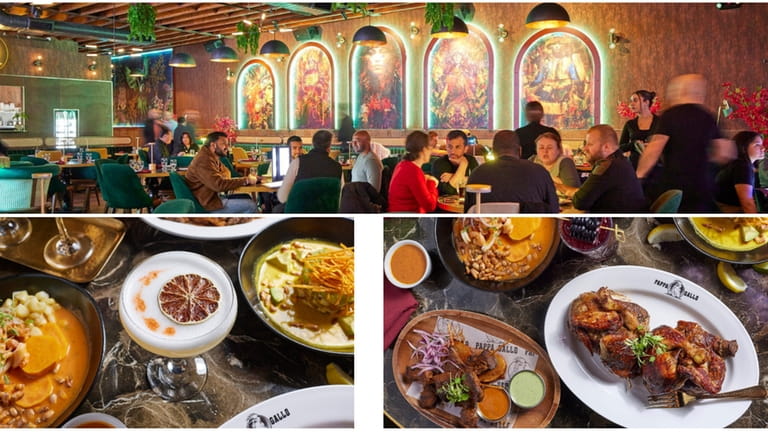
Ceviche Nikkei with cubed scallops, shrimp and octopus over a spicy-Asian emulsion, topped with wasabi caviar and toasted corn, garnished with scallions and fried sweet potato at Pappagallo in Rockville Centre. Credit: Yvonne Albinowski
Vibe: This kaleidoscope of an eatery dazzles with color, live entertainment, and buzz. Peruvian chef Emmanuel Piqueras draws on his native cuisine and experience as a private chef to the former president of Peru to deliver traditional dishes with balance and authenticity.
Passionfruit Pisco Sour at Pappagallo in Rockville Centre. Credit: Yvonne Albinowski
What to order: Ceviche, both classic and Nikkei (Japanese-influenced), run $18-$23; pollo ala brasa, a 24-hour marinated French rotisserie-cooked chicken ($29) falls off the bone; cocktails like the Pisco Sour ($16) and the Chicha Morada Pisco pair nicely.
More info: 516-208-3220; myypappagallo.com
Inka Fe Bakery, Great Neck
178 Middle Neck Rd.
Vibe: This gem serves as an all-day cafe and restaurant run by a Peruvian mother-daughter team. With nine tables, it’s cozy and comfortable, and the staff goes out of their way. Karaoke on Fridays.
What to order: Marjry Moreno’s maracuya (passionfruit) and lucuma mousses ($7) are smooth and sweet, but it’s the alfajores ($3), dulce de leche cookies covered in powdered sugar that are transcendent.
More info: 516-765-0269, theinkafe.com
Pio Pio, Glen Cove
51 Cedar Swamp Rd.
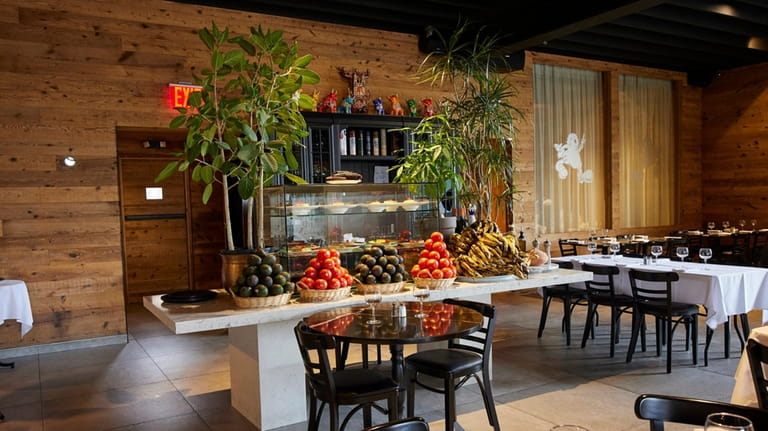
The interior of Pio Pio in Glen Cove. Credit: Yvonne Albinowski
Vibe: Unlike the fast-casual hustle of many of the Pio Pio locations in New York City, the Glen Cove location is a cavernous space with an equally large bar that reads way more upscale than its city cousins.
Ceviche Limeno with corvina, lime juice, red onions, cilantro, rocoto and Juanita's chicken at Pio Pio in Glen Cove. Credit: Yvonne Albinowski
What to order: It’s all about the pollo ala brasa here, the addictive, pillow-soft poultry named after “Mama Juanita” that bastes for 12 hours in a garlic, cumin, pepper and Peruvian beer marinade. Paired with the equally addictive green cilantro sauce, it’s hard to visit Pio Pio and skip the pollo. From $7 to $24.
More info: 516-667-6868, piopiony.com
La Candela, Commack and Hicksville
6061 Jericho Tpke., Commack (631-486-4793) and 495 S. Broadway, Hicksville (516-470-0805)
Vibe: The OGs of Peruvian food on Long Island, these lively spots are filled with large Latino families in celebration — a telling endorsement — and couples on dates. The white walls and neon lighting feel a little “Miami Vice,” but the delightful Elvin Paulino and his wife, Elizabeth, deftly deliver all the classics.
What to order: Chupe de camarones ($24), ceviche de pescado ($21) to start; jalea, a fried seafood platter topped with chopped onions and tomato ($32, for two), and lomo saltado ($22) to share. Try a Chilcano (lime, pisco and ginger ale) to wash it down.
Picchu, Selden
1245 Middle Country Rd.
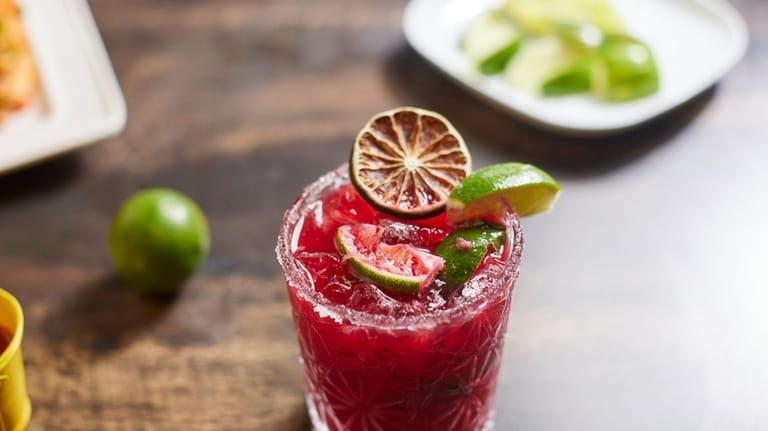
Picchu margarita at Picchu in Selden. Credit: Yvonne Albinowski
Vibe: Casual and fun, the cozy space boasts a chicken mural on one side of the restaurant and hip llama prints on the other. Sunny by day, the vibe shifts in the evenings when sangria dots most tables.
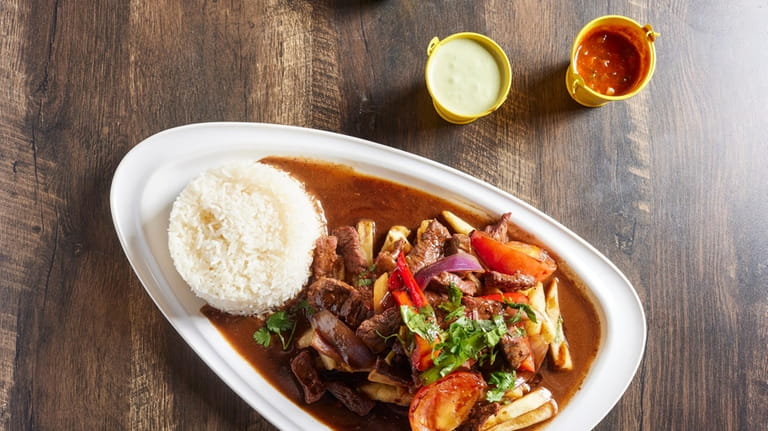
Lomo saltado with beef sirloin, red peppers, onions, tomato and soy sauce served over fries and rice at Picchu in Selden. Credit: Yvonne Albinowski
What to order: The leche de tígre ceviche ($15.50) here is off the charts. Try one of the family-style combos like the Picchu Picada ($35.95) to start, which offers tastes of mussels (choros), papa a la huancaína, ceviche, and jalea, or the Picchu Platter ($44.95) highlighting anticuchos, Peruvian chicken, chaufa, and lomo saltado.
More info: 631-320-0206

